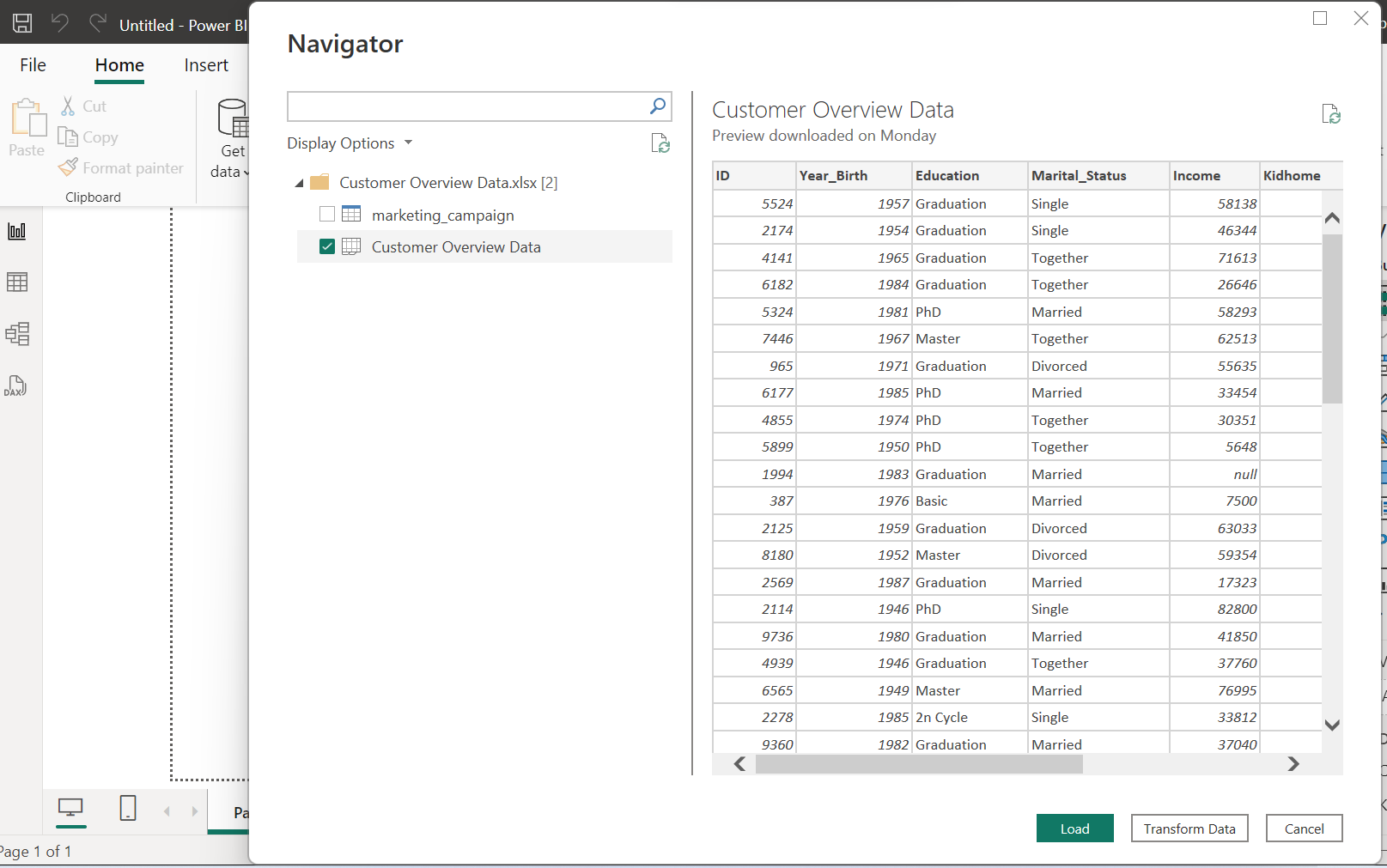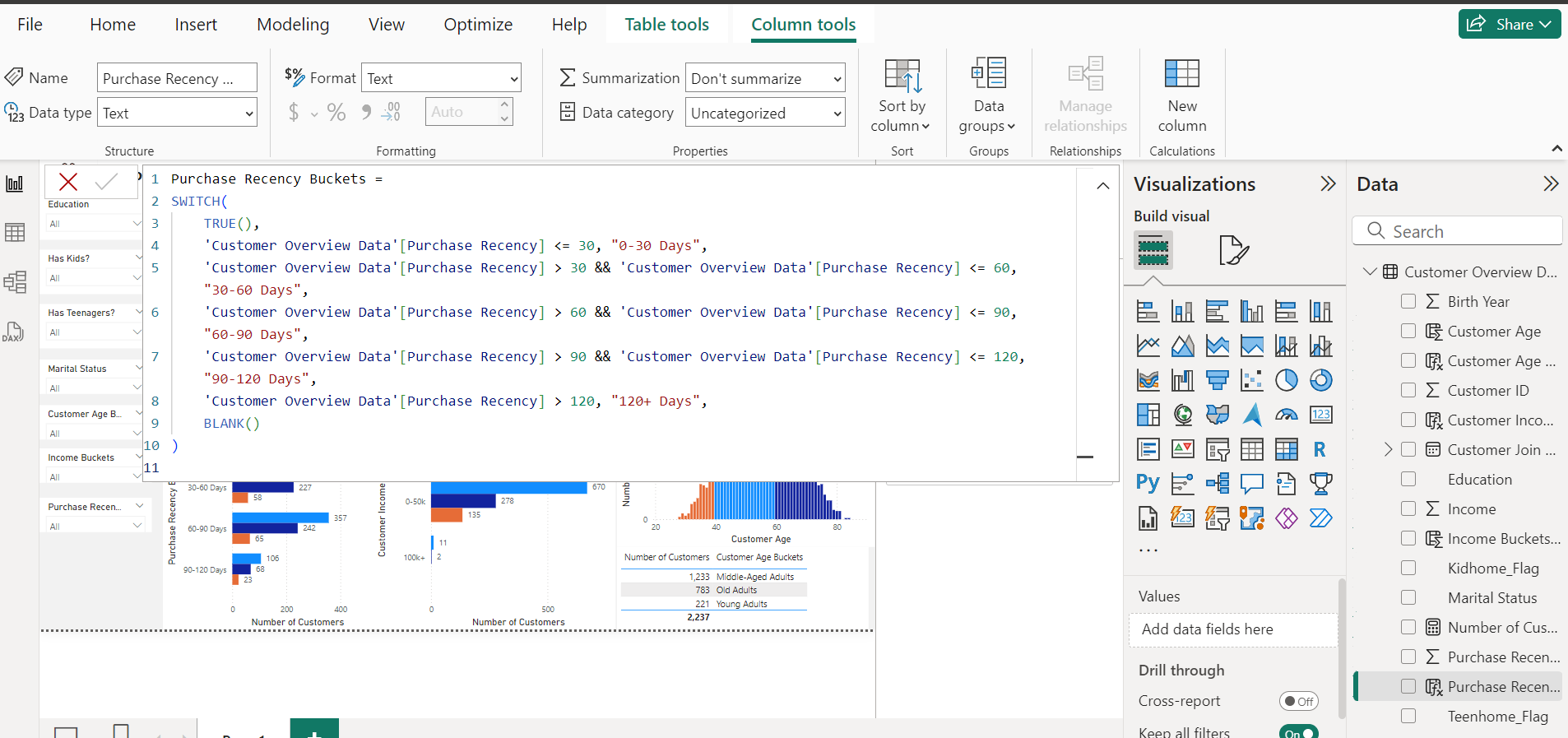Customer Overview Analysis
Business Request & User Stories
Request For The Customers Overview Analysis
Dear Data Analyst;
We need your expertise to develop a dashboard for our “Customer Overview Analysis” that displays our key performance metrics for informed decision-making.
Requirements
Create a visualization to analyse;
* Number of Customers
* Number of customers by Purchase Recency
* Number of customers by Age Group
* Number of customers by Income
* Number of customers with Kids
* Number of customers with Teens
* Number of Customers by Education
Design & Aesthetics: Use our company colors and ensure that the dashboard is easy to navigate.Data Source: Access to our databases will be provided.
Deadline: We need a preliminary version ASAP.
Please provide an estimated timeline for completion and recommendation based on the insightts and key-learnings deduced from the analysis
Best regards,
Project Overview:
The primary goal of this analysis is to uncover insights from the customer overview data, which can inform strategic decisions to better understand and cater to the customer base. By analyzing various aspects of the customers, the business can improve its strategies to enhance customer satisfaction, retention, and overall growth.
Objectives:
- Demographic Profiling:Understand the demographic characteristics of the customer base.
- Segmentation Analysis: Segment customers based on age, income, and other relevant factors to identify key customer groups.
- Customer Lifecycle Analysis: Analyze customer tenure and purchase recency to understand customer lifecycle stages.
- Family and Household Insights: Examine household composition to tailor family-oriented products and services.
- Educational and Marital Status Impact:Assess how education and marital status influence customer behavior and preferences.
Key Metrics:
1.Customer Demographics:Customer Age, Customer Age Bracket,Education,Marital Status,Income,Income Bracket.2.Household Composition:Kid Home: Number of kids in the household.Teenhome: Number of teenagers in the household.3. Customer Tenure:Customer Join Date: Date when the customer joined.Purchase Recency: Number of days since the last purchase.4. Customer Segmentation:Segments based on age, income, education, marital status, and household composition.
The project workflow is explained below;
1. Data Collection
2. Data Modelling
3. Data Analysis
4. Data Visualization
5. Insights & Key-Learnings
1. Data Collection
2. Data Modelling

3. Data Analysis




4. Data Visualisation
5. Insights & Key-Learnings
Recommendations:1. Targeted Marketing Campaigns:Families with Kids and Teens:With a significant portion of customers having kids (42.29%) and teens (48.32%) at home, create family-oriented promotions and products.Offer discounts or bundles on products suitable for families.Age-Based Targeting:Young Adults: Focus on emerging trends and tech-savvy products.Middle Adults: Highlight convenience and value for money in promotions.Old Adults: Emphasize quality and reliability in products and services.2. Income-Specific Strategies:$50k-$100k Income Bracket:Middle and old adults in this bracket form a substantial portion. Tailor promotions that emphasize value and long-term benefits.$0-$50k Income Bracket:Middle-aged customers in this bracket are significant. Consider offering affordable pricing options, payment plans, and discounts.>$100k Income Bracket:Although small, focus on exclusive and premium products for high-income middle-aged customers.3. Engagement Based on Purchase Recency:0-30 Days Recency:Engage middle-aged (402) and old adults (246) with follow-up offers and loyalty programs to maintain engagement.30-60 Days Recency:Re-engage customers with personalized offers based on past purchases.60-90 Days Recency:Use targeted campaigns to bring back customers who haven’t purchased recently, perhaps with special incentives or reminders of previous interests.4. Educational Attainment Insights:Graduate and Higher Education:Since a significant portion of customers are graduates (50.38%), emphasize educational and informational content in marketing.Offer products and services that appeal to the knowledge-driven and quality-conscious nature of these customers.Implementation Plan:1. Data-Driven Campaigns:Use the demographic, income, and purchase recency data to create detailed customer personas.Develop targeted marketing campaigns that align with the needs and preferences of each segment.2.Promotional Offers:Design specific promotional offers for families, young adults, middle-aged, and older adults.Create exclusive deals for higher-income segments and value-oriented offers for lower-income segments.3.Customer Engagement Programs:Implement loyalty programs for customers with recent purchases to encourage repeat business.Send personalized email campaigns based on purchase history and recency to re-engage inactive customers.4.Educational Content:Produce content that resonates with the highly educated segment, such as webinars, detailed product guides, and informative articles.Highlight product features that appeal to a well-educated audience, focusing on quality, innovation, and value.Conclusion:By leveraging these insights and recommendations, the business can better understand its customer base and tailor its strategies to meet their needs. This approach will likely lead to increased customer satisfaction, higher engagement, and improved overall performance. Regularly updating and analyzing customer data will ensure the business remains responsive to changing customer dynamics and preferences.